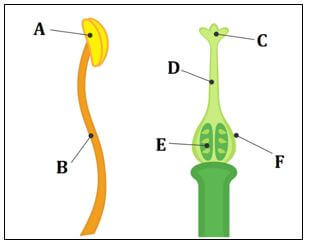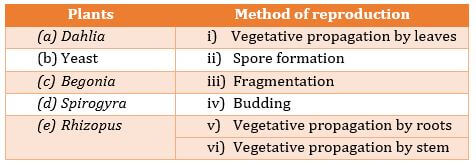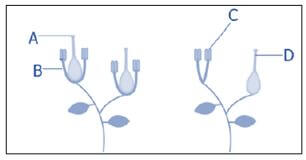Reproduction in Plants Worksheet
Objective Type Questions
- Fill in the blanks by choosing the most appropriate words from those given in the brackets.
(stigma, receptacle, stamen, corolla, unisexual, pistil, calyx, bisexual, style)
(a) The base of a flower to which all the parts of a flower are attached is called …………….
(b) All sepals taken together constitute the ……………. while all petals together constitute the …………….
(c) ……………. is the male reproductive organ while ……………. is the female reproductive organ of the plant.
(d) Flowers which contain only one reproductive organ are called ……………. flowers.
(e) ……………. receives pollen grains from the anther of stamen during pollination. - The diagram below shows the structure of male and female reproductive parts of a plant. Label the parts A, B, C and D correctly choosing the appropriate terms from those given in the brackets.
(ovule, anther, stigma, filament, style, ovary)
- Match the terms in column A with appropriate terms in column B.
Multiple Choice Questions - Which of the following statements correctly defines the term “reproduction”?
(a) Production of new individuals from parents
(b) An increase in height and weight of an organism
(c) The ability of an organism to withstand unfavourable conditions
(d) The development of an individual physiologically and emotionally - A farmer has an apple tree in his garden, which bears sweet apples every year. The farmer wants to add more trees of this variety his garden. Which life process of the plant will allow the farmer to produce more such plants?
(a) Growth
(b) Reproduction
(c) Respiration
(d) Transportation
- Kirti and Trupti were asked to grow different plants. Kirti used the stem of a rose plant and buried it into the soil to produce a new rose plant. Trupti used the seed of a cucumber plant and buried it into the soil to grow a new cucumber plant. After few weeks, the growth of the rose plant and the cucumber plant was observed. What mode of reproduction took place in the plants chosen by Kirti and Trupti?
(a) Kirti - Sexual reproduction; Trupti - Sexual reproduction
(b) Kirti - Sexual reproduction; Trupti - Asexual reproduction
(c) Kirti - Asexual reproduction; Trupti - Sexual reproduction
(d) Kirti - Asexual reproduction; Trupti - Asexual reproduction - A teacher visited a vegetable farm with students. The chart shows the plants growing in that farm.
Pumpkin, Mustard, Bryophyllum, Tomato
The teacher pointed out to a plant and said that its mode of reproduction is different from the other three plants. Which plant might have been pointed out by the teacher, and why?
(a) Tomato plant as it reproduces sexually, while the other three plants reproduce asexually.
(b) Pumpkin plant as it reproduces asexually, while the other three plants reproduce sexually.
(c) Bryophyllum plant as it reproduces asexually, while the other three plants reproduce sexually.
(d) Mustard plant as it reproduces sexually, while the other three plants reproduce asexually.
- The table shows the area of a pond in percentage covered by green algae within 20 days.
A student claimed that algae reproduce sexually and grow rapidly in the pond. Is the claim made by the student, correct?
(a) Yes, Algae reproduce sexually by means of spores.
(b) Yes, Algae reproduce sexually by means of gametes.
(c) No, Algae reproduce asexually by means of budding.
(d) No, Algae reproduce asexually by means of fragmentation.
- A potato plant does not produce seeds, but it produces new plants by means of vegetative propagation. The chart lists some parts of a potato plant.
What plant part governs asexual reproduction in a potato plant?
(a) Flowers
(b) Leaves
(c) Eyes of potato
(d) Cutting of its stem
- A teacher showed a piece of ginger to the students from which several sprouts were coming out. Later, the teacher asked the students to observe a slide showing reproduction in a yeast cell. What modes of reproduction have been studied by the students in both these specimens?
- Different plants use different parts to produce new plants as shown in the table.
Which of the above plants reproduces sexually?
(a) Bryophyllum
(b) Sweet potato
(c) Cactus
(d) China rose
- The image represents the female and the male reproductive parts of two different flowers.
A teacher asked a student to identify the label that represents pollen grain-containing part of a bisexual flower. Which label should be chosen by the student?
(a) A
(b) B
(c) C
(d) D
- The table shows some plants grouped under two groups, 1 and 2 based on the difference in their outcomes of sexual reproduction.
Which other plant can be included in group 1?
(a) Cucumber
(b) Mango
(c) Petunia
(d) Tomato
- The table shows the features possessed by seeds of four different plants.
Seeds of which plant have the features to disperse better in water?
(a) Aak
(b) Coconut
(c) Drumstick
(d) Xanthium
Subjective Questions - Rishi is confused between the asexual and the sexual modes of reproduction. Given below are some characteristics of reproduction. Sort them as characteristics of asexual and those of sexual reproduction respectively to help Rishi clear his doubt.
- Rajat stays in the Konkan region of Maharashtra while Kranti stays in Nagpur. When Rajat had visited Kranti’s house during vacations, he noticed that the plants which grow in Konkan, grew in Nagpur as well.
(a) How do same kind of plants grow at different places?
(b) What will happen if all the seeds of a plant were to fall at the same place and grow there?
- Observe the figures given below and answer the questions based on them.
(a) Which processes do figures A and B represent?
(b) How are these two processes different from one another?
(c) List three agents which carry out the given processes. - Given below are some characteristics of flowers. Sort these characteristics according to the agent of pollination – pollination by wind, water, or insects.
Case-Based Questions
- Organism X is used in the baking industry to manufacture breads and cakes. Addition of X into the bread dough allows it to rise and increase in volume. The bread formed in spongy and light. When this bread is left exposed to moisture for 3-4 days, growth of organism Y takes place on the bread. A researcher took samples of X from the dough of bread on slide A, and samples of Y from the spoilt bread on slide B and observed the growth of these organisms under the microscope.
a) What are X and Y likely to be in the above case?
(a) X – Spirogyra; Y - Yeast
(b) X – Spirogyra; Y - Rhizopus
(c) X – Rhizopus; Y - Yeast
(d) X – Yeast; Y - Rhizopus
b) What type of asexual reproduction might have been observed by the researcher on slides A and B?
(a) A - Budding, B - Fragmentation
(b) A - Spore formation, B - Budding
(c) A - Budding, B - Spore Formation
(d) A - Fragmentation, B - Spore Formation
c) Which of the following plants reproduce by the same method as Rhizopus?
(a) Moss and Fern
(b) Fern and Cactus
(c) Moss and Cactus
(d) Ginger and Potato
- Seeds and fruits of the plants are dispersed by wind, water, and animals. Some seeds are also dispersed by an explosive mechanism in which the ripe fruits of some plants burst on their own and throw their seeds away from the plant with a great force.
a) Which of the following is incorrectly matched?
(a) Begonia – Dispersal of seeds by wind
(b) Water lily – Dispersal of seeds by water
(c) Xanthium – Dispersal of seeds by explosive mechanism
(d) Urena – Dispersal of seeds by animals
b) By which of the following modes dispersal of fruits and seeds occurs in the castor plant?
(a) Water
(b) Explosive mechanism
(c) Wind
(d) Animals
c) If the seeds of a plant are dispersed by wind, which of the following features are possessed by its seeds?
(a) Fibrous outer coat
(b) Spongy outer coat
(c) Numerous hooks
(d) Wing-like structures
d) Which characteristic feature is not matched correctly?
(a) Sunflower – Hairy fruits
(b) Orchids – Small and light seeds
(c) Water lily – Numerous hooks
(d) Maple – Winged seeds
Assertion-Reasoning Questions
Below questions consist of two statements – Assertion (A) and Reason (R). Answer these questions selecting the appropriate option given below: - Assertion (A): Hibiscus is a bisexual flower.
Reason (R): It contains both male as well as female reproductive organs.
- Assertion (A): The fusion of male and female gametes to form a zygote is called fertilisation.
Reason (R): The process of fertilisation occurs after the pollen grains fall on the stigma of a flower.
Explore more Science Sample papers and Solutions
-
Sample Papers for CBSE Class 7 Science Term 1 #1
-
Sample Papers for CBSE Class 7 Science Term 2 #1
-
Nutrition in Plants Worksheet
- Nutrition in Animals Worksheets
- Heat Worksheet
- Acids, Bases And Salts Worksheet
- Physical And Chemical Changes Worksheet
- Respiration in Organisms Worksheet
- Transportation In Animals And Plants Worksheet
- Motion And Time Worksheet
- Electric Current And Its Effects Worksheet
- Light Worksheet
- Forests: Our Lifeline Worksheet
- Wastewater Story Worksheet
- Competency Based Questions for CBSE Class 7 Science
- Sample Papers for CBSE Class 7 Science Term 1 #2
- Sample Papers for CBSE Class 7 Science Term 2 #2
Key Features of Study Materials of CBSE Class 7 Science:
- Easiest and most comprehensive study materials
- Designed by subject matter experts
- Revised according to the latest CBSE syllabus
- Helpful for quick revision
- ‘Ask a Doubt’ facility
- Significant improvement in marks



















